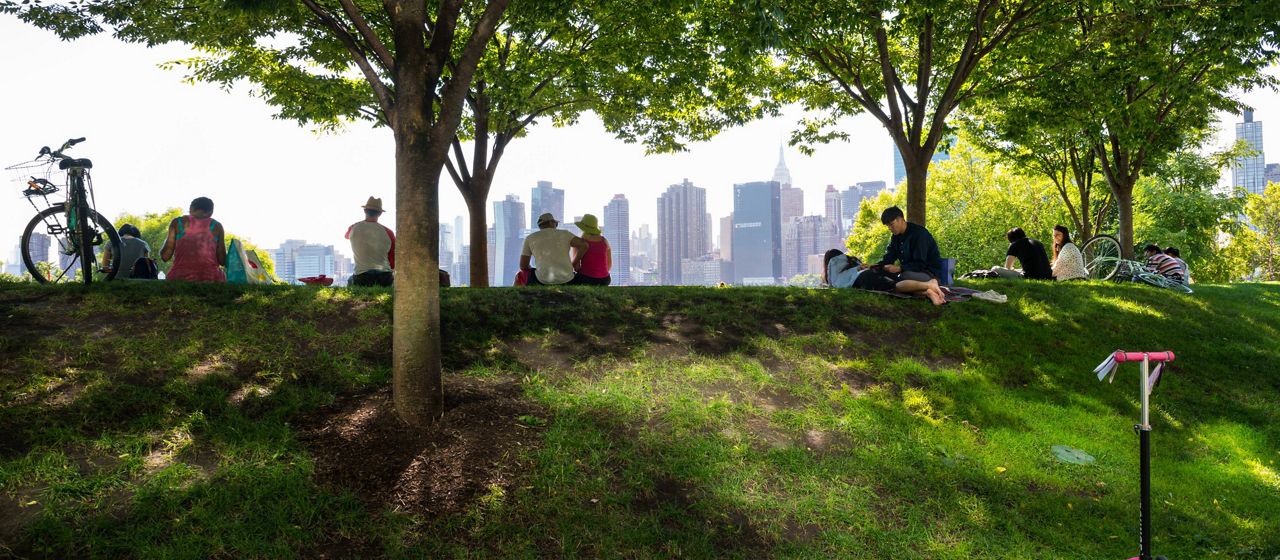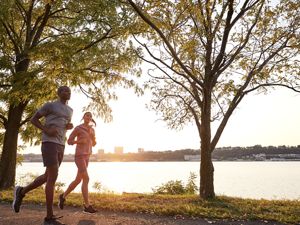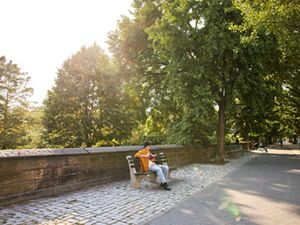
Gantry Plaza State Park This stretch of waterfront along the East River in Queens was reborn as a residential area—and those new residents wanted parkland. © Diane Cook and Len Jenshel
Summers in New York City are like none other. In my memories of growing up in Queens in the 2000s, I can still hear the laughter of children echoing through the streets, reminding me that this bustling metropolis was our playground, our sanctuary for adventure. The streets were filled with people—families strolling hand-in-hand and friends gathering in parks and on stoops. The energy of the city harmonized with the warm sun, which cast a golden glow on everything it touched.
But I also remember the scorching heat.
I knew the secret to surviving the heat was finding the solace of shade beneath trees. Today, New York summers are hotter than ever. Extreme heat is the leading weather-related cause of death nationally, and some New Yorkers are more vulnerable to this than others. Unfortunately, the respite provided by the trees I cherished is not equitably distributed across New York City neighborhoods, particularly in low-income communities and communities of color. That’s why The Nature Conservancy launched Future Forest NYC in 2019―an initiative to ensure that the social and environmental benefits the New York City urban forest provides are shared in a just and equitable way. This includes supporting a robust understanding of the NYC urban forest through science, supporting local stewardship work with partners, and convening and serving as a leading member of Forest for All NYC, a diverse coalition of over 120 members and growing.
Tree canopy is the layer of leaves and branches from trees that cover the ground from a bird’s-eye view, offering a wide range of benefits, such as those illustrated above.
Tree Canopy: A Vital Part of the Urban Forest
The NYC urban forest includes over 7 million individual trees across public and private property, as well as the associated soil and various plants and animals that makes their homes there or pass through. A key part of the urban forest is tree canopy, or the layer of leaves and branches from trees that cover the ground from a bird’s-eye view.
Canopy itself provides shade and can serve as habitat for numerous animals such as migrating birds, while offering various other benefits. However, it is just one part of the urban forest. Other essential elements of the urban forest include policy and funding that help trees thrive, and people—such as those who care for, study and advocate for trees. We can all be part of the NYC urban forest.
Based on legislation passed with the support of Forest for All NYC, the City is now working toward a goal of 30% canopy citywide through multiple lenses, including equity, and in advancing the NYC Urban Forest Agenda, Forest for All NYC seeks to achieve this by 2035. It is important that local perspectives and needs help shape what this looks like.
Learn about the tree canopy and opportunities for more in your area through the fact sheets available below. Use them on your own or with local organizations to advance more equitable canopy in your neighborhood. Click on the map below.
Local Canopy Fact Sheets
Learn about Tree Canopy in Your Community:
- First, click on your borough.
- Then, select City Council or Community District, and click on the label for the area of interest.
Unsure of your City Council District or Community District?
Neighborhoods in Queens
Find your neighborhood in Queens for specific facts about your local tree canopy.
Unsure of which City Council District of Community District you are in?
Neighborhoods in the Bronx
Find your neighborhood in the Bronx for specific facts about your local tree canopy.
Unsure of which City Council District of Community District you are in?
Neighborhoods in Manhattan
Find your neighborhood in Manhattan for specific facts about your local tree canopy.
Unsure of which City Council District of Community District you are in?
Neighborhoods in Brooklyn
Find your neighborhood in Brooklyn for specific facts about your local tree canopy.
Unsure of which City Council District of Community District you are in?
Neighborhoods in Staten Island
Find your neighborhood in Staten Island for specific facts about your local tree canopy.
Unsure of which City Council District of Community District you are in?
Keeping trees healthy and expanding their canopy helps sustain and increase the urban forest’s many benefits, from keeping areas cooler in the summer by reducing the urban heat island effect, to absorbing stormwater, and supporting people’s wellbeing and quality of life. As the frequency and intensity of storms and deadly heat waves increase with climate change, the urban forest is critical for minimizing impacts on New Yorkers.
Join Our Newsletter
Sign up to receive monthly conservation news and updates from New York.




